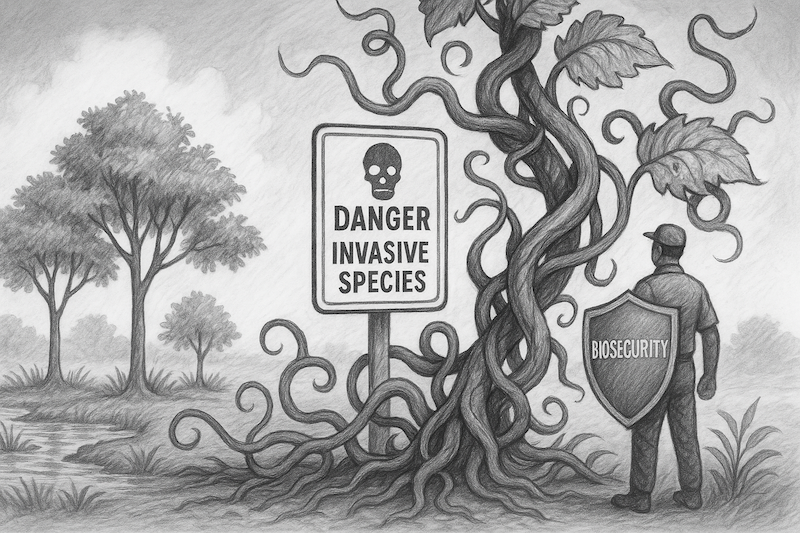Invasive Species: Silent Invaders in a Globalised World
Trade, travel, and transport have become the dominant vectors of biological invasion in the modern era. A glance at India’s ecological history reveals how foreign species, introduced accidentally or deliberately, have upended native ecosystems and inflicted immense economic costs.
One early example is the giant African snail, introduced in colonial Calcutta around 1847—possibly as a curiosity from East Africa. The snail flourished in India’s climate, unchecked by predators, displacing native snails and harming agriculture. It even carried rat lungworm, a dangerous parasite.
India’s expanding global trade footprint, especially post-independence, has made it both a major importer and exporter of exotic species. These include ornamental fish like guppies and angelfish, introduced for aquarium hobbyists, and biological control agents like Gambusia, intended to combat mosquito larvae but now outcompeting native aquatic fauna.
Trade Agreements: A Double-Edged Sword
The 21st-century boom in bilateral and multilateral trade agreements—from 76 countries forming 5,700 trade pairs in 1948 to over 34,000 pairs by 2020—has increased the frequency of species introductions. Tariff wars, such as those initiated by former U.S. President Donald Trump, have further redirected trade routes, leading to new and unregulated biotic flows between previously disconnected ecosystems.
The risk isn’t limited to land. Maritime routes facilitate biofouling and ballast water exchange, carrying foreign marine organisms thousands of miles. The Asian paddle crab, introduced to New Zealand via shipping from East Asia, is one example. It now poses a serious aquatic health risk, carrying viruses like white-spot syndrome.
India’s Troubled Past with Invasive Species
-
Tilapia, introduced to boost protein availability, now threatens native fish biodiversity in Indian rivers.
-
Parthenium hysterophorus, or "Congress grass", entered via contaminated American wheat in 1955 under the PL 480 agreement. It spread aggressively across India, disrupting ecosystems and causing allergies and dermatitis in humans.
-
According to a 2022 study, India has lost $127.3 billion due to invasive alien species since 1960—making it the second-most financially impacted country after the U.S.
Yet, these figures only scratch the surface. Less than 3% of known IAS in India have been assessed for economic damage, leaving the full extent of the threat vastly underreported.
Why New Trade Ties Increase Risk
Trade protectionism often leads to diversification of trade partnerships. New alliances, hastily formed to bypass tariffs, often lack the institutional checks, coordinated quarantine mechanisms, and biological risk assessments that traditionally accompany established trading routes. Many low- and middle-income nations lack customs biosecurity protocols, making it easy for alien species to enter through food, timber, grains, or aquarium stock.
This is particularly alarming in India, where the regulatory apparatus remains fragmented across ministries, and enforcement mechanisms at ports remain weak.
One Biosecurity: The Policy Imperative
The need of the hour is a cohesive national strategy to prevent biological invasions. This should include:
1. Stronger Quarantine and Border Control
India must build real-time species tracking, DNA barcoding stations at ports, and better-trained personnel to monitor high-risk imports.
2. Unified Governance under 'One Biosecurity'
Like the One Health approach that links human, animal, and environmental health, One Biosecurity proposes integration across agriculture, environment, and health ministries. A centralised IAS authority could help coordinate surveillance, reporting, and risk mitigation.
3. Post-Import Biological Impact Assessments
Mandatory assessments of biological impact for high-risk goods like aquarium fish, grains, and timber should be enforced in quarantine labs before release into Indian markets.
4. Public Awareness and Citizen Science
Most invasions go unnoticed until they explode in scale. Public education campaigns and mobile apps to report unfamiliar species can help track spread early.
5. Pre-Trading Biological Agreements
All future trade treaties must include biodiversity safeguard clauses, with shared responsibilities on ecological risks and financing for mitigation infrastructure.
Lessons from the Past, Warnings for the Future
The devastating ecological and financial impact of Lantana, Water Hyacinth, Prosopis juliflora, and the yellow fever mosquito serve as stark reminders of what’s at stake. These species continue to affect agriculture, water infrastructure, and public health, with ripple effects on livelihoods and biodiversity.
And yet, future invasions may be even harder to contain. Rising temperatures, urban sprawl, and climate-induced habitat shifts will likely facilitate the survival and spread of more alien species.
As trade expands, India must not repeat past mistakes. The cost of inaction today will be borne by future generations—not in trade imbalances, but in irreversible ecological collapse.






